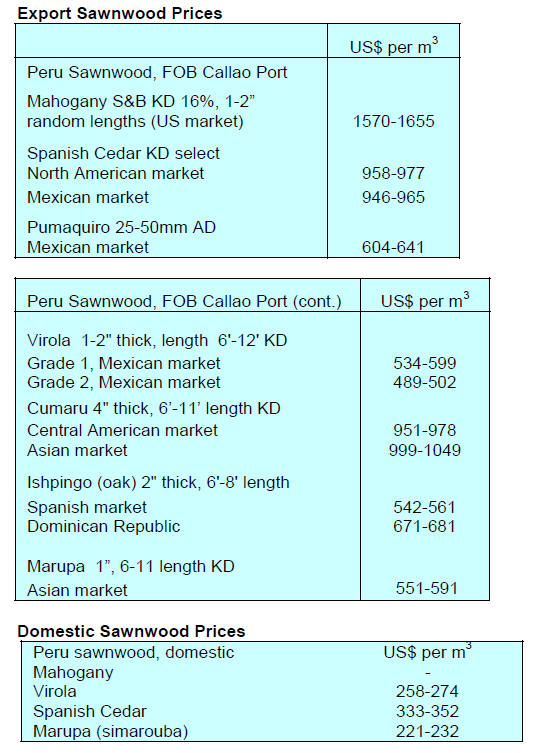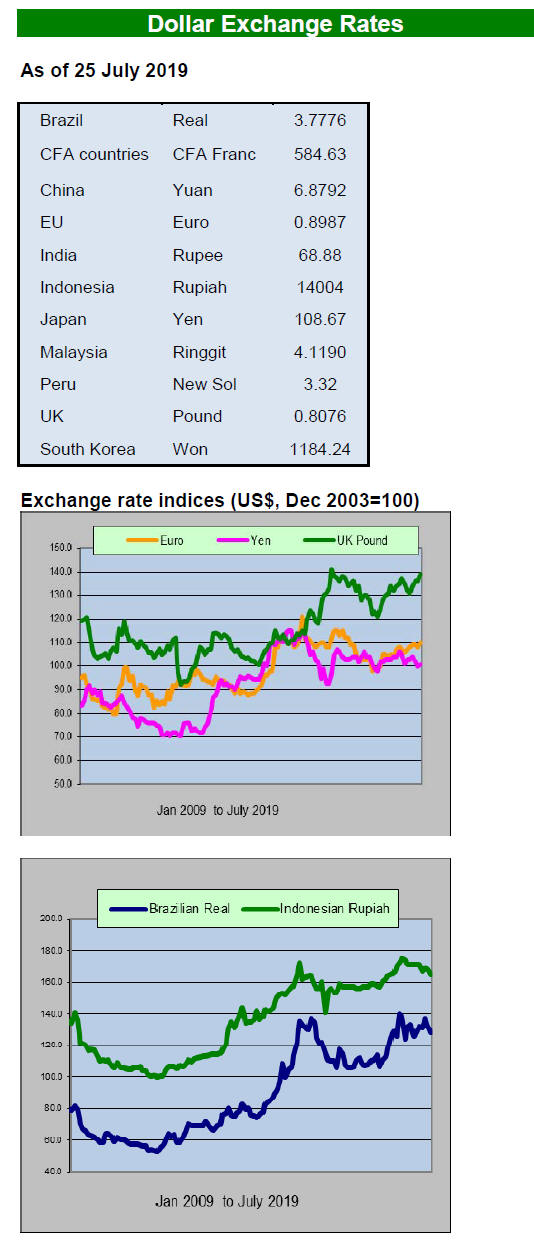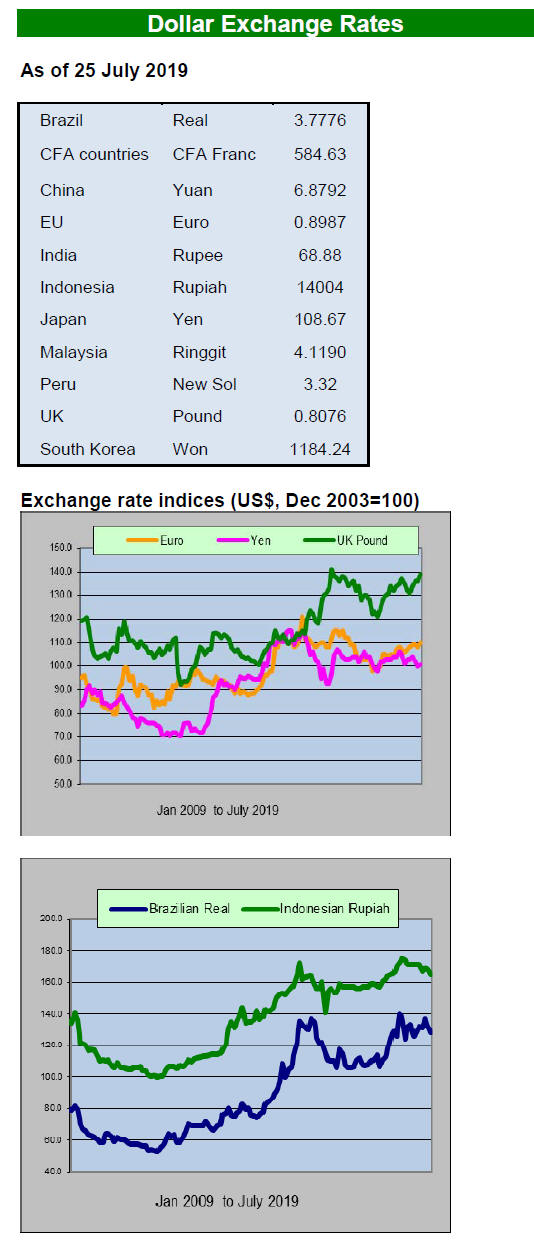3.
MALAYSIA
An opportunity to bring down
regional shipping costs
Trading between Brunei, Indonesia, Malaysia and the
Philippines will get a boost following the new shipping
service launched by Reefer Express Lines.
The launching of the service was initiated by the East
ASEAN Growth Area (BIMPT-EAGA) Business Council
through a memorandum of understanding aimed at
increasing trade volume within the BIMP-EAGA region.
Analysts say the new service could bring down costs and
cut shipping times.
For more see: https://www.hellenicshippingnews.com/new-linershipping-
operations-set-to-increase-cross-border-trade-withinbimp-
eaga-region/
ASEAN mutual recognition for timber legality
Delegates from Indonesia, Thailand, Vietnam, Myanmar,
Cambodia, Brunei and Malaysia recently met to discuss a
regional mechanism for mutual recognition of timber
legality definitions.
The objectives of this meeting were:
 to enhance understanding through sharing
to enhance understanding through sharing
experiences on developing MRA from other
sectors referring to the ASEAN Framework
Agreement on Mutual Recognition Arrangements
(MRA 1988) and Guidelines on Accreditation
and Conformity Assessment;
 to discuss the requirements for MRA
to discuss the requirements for MRA
development and clearly identify the
steps/processes on setting standards and
procedures to be followed and how to move the
process forward;
 to discuss a stepwise approach and timeline on
to discuss a stepwise approach and timeline on
ASEAN regional mutual recognition arrangement
for AMS on timber legality
The meeting agreed on a five year timeline for
implementation.
See: http://www.mtib.gov.my/en/maskayu/category/35-
emaskayu-2019
Furniture exports a major contributor to export
earnings
Teresa Kok, Malaysia’s Minister of Primary Industries,
has reported that timber exports in the first 5 months of
2019 rose 2.3% year on year.
Malaysia is one of top ten global furniture exporters and in
the first five months of 2019 the furniture industry
contributed 36% to Malaysia’s total timber-related
exports, up almost 13% year on year. She remarked that
Malaysian manufacturers need to be alert as non-wood
products are a threat in some of the traditional wood
product markets.
See: https://www.thesundaily.my/business/malaysia-s-timberexports-
hit-rm9-1b-in-first-five-months-of-2019-CD1151848
Malaysian Wood Expo
The Malaysian Timber Council (MTC) and the publisher
of the magazine Panels and Furniture are jointly
organizing the Malaysian Wood Expo (MWE 2019)
scheduled to be held 19 to 21 November 2019 at the Putra
World Trade Centre in Kuala Lumpur.
MWE 2019 is expected to attract the finest international
wood-based manufacturers, exporters as well as
woodworking machinery suppliers and buyers.
See:
http://www.malaysianwoodexpo.com.my/
Plywood prices
Plywood traders based in Sarawak reported the following
June export prices.
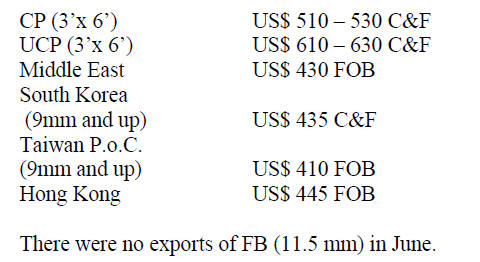
4.
INDONESIA
Industry optimistic exports
can be boosted
There is growing optimism that the value of wood product
exports (excluding pulp and paper) could reach US$3.09
billion by 2025. Soewarni, Chairman of the Indonesian
Sawmill and Woodworking Association (ISWA), said this
would be possible if the supply of logs can be verified
legal and if global demand picks up.
Bambang Supijanto, Chairman of the Indonesian Wood
Panel Association (Apkindo), projected the value of wood
based panel exports in 2025 could be as high as US$2.47
billion from a volume of around 4 million cubic metres.
On the issue of log supply, Secretary General of the
Ministry of Environment and Forestry (KLHK), Bambang
Hendroyono, believes future log sources will develop as
community plantation forests and industrial plantations
expand. To encourage this expansion, Bambang said
efforts would be made to help community forestry licenses
holders build small-scale wood processing facilities as this
would encourage further investment in plantations.
In the first six months of 2019, the value of processed
wood product exports was US$5.58 billion, down almost
6% year on year.
Wooden furniture export were US$695.2 million down
slightly year on year, panel exports were valued at
US$1.05 billion, down a massive 16% year on year mainly
because of weak demand in Japan. Paper exports earned
US$1.93 down slightly from a year earlier but, in contrast,
pulp exports rose around 2% and veneer exports, at
US$48.50 million, were down 9% year on year.
In commenting on the export figures, the Chairman of the
Association of Indonesian Forest Concessionaires (APHI),
Indroyono Soesilo, said that the trade war between China
and the United States was one of the causes of declining
demand for processed wood.
In related news, Purwadi Soeprihanto, Executive Director
of the Association of Indonesian Forest Concessionaires
(APHI), said the market for mouldings from Indonesia
could rise to US$1.17 billion as Indonesia has the potential
to produce 1.7 million cu.m of mouldings, 200,000 cu.m
from natural forests raw material and 1.5 million cu.m
from plantations.
See:https://industri.kontan.co.id/news/cuma-mencapai-us-558-
miliar-ekspor-kayu-olahan-turun-563-di-semester-i-2019
Raw material exports – short term solution to address
trade deficit
Indroyono Soesilo, Chairman of APHI, proposed that the
short-term solution to lower Indonesia's trade deficit
would be to optimise harvesting and trade in natural
resources, notably timber raw materials which he said are
100% local content and do not require imports of capital
goods. Plantation owners in Indonesia have long been
seeking permission to export plantation logs.
At the same time, Indroyono pointed out that there are
opportunities to export wood pellets to Japan and South
Korea.
In support of this suggestion, Purwadi Soeprihanto, the
APHI Executive Director, said that international demand
for wood pellets is huge. In South Korea, the demand for
wood pellets is supported by government policies that will
provide tax incentives if the industry uses renewable
energy from biomass.
See;
https://ekonomi.bisnis.com/read/20190710/99/1122389/trenenergi-
terbarukan-buka-peluang-ekspor-pelet-kayu-ke-jepangdan-
korsel
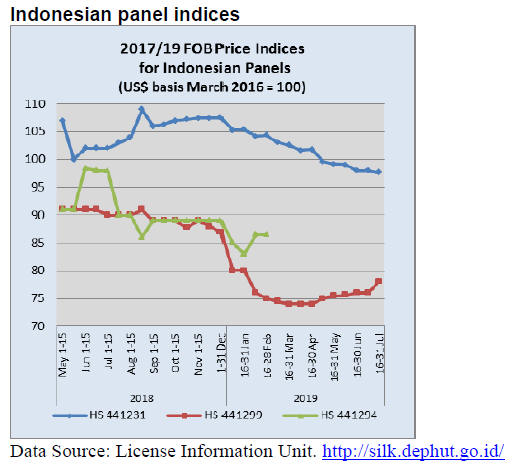
5.
MYANMAR
Exports face uncertain future
in EU market
According to the Ministry of Trade, exports of wood
products declined around 13% between October to June of
2018-19. From October 2017 to June 2018 export earnings
totalled US$147.456 million while they were US$128.637
million between October 2018 and June 2019. According
to analysts, exporters are facing growing uncertainty
especially with respect to exports to the EU.
According to a report by the Extractive Industries
Transparency Initiative (EITI) Myanmar report the
Sagaing Region was the top teak producer in the two years
of 2014-15 and 2015-16 accounting for 46% of national
teak production. In second place was Shan State which
contributed a further 27%.
FDI company to produce yachts
Shinkwang Marine Company, a new foreign venture in
Myanmar, has been given approval to build yachts in the
country. It is common for teak to be used for interior trim
in yachts.
Analysts writes “ although details of the type of yachts
that will be built is not yet known this may be a first step
to bring boat building for export to Myanmar”.
Stalled Dawei special economic zone project to be
discussed at international gathering
The governments of Myanmar, Japan and Thailand will be
meeting over the troubled Dawei special economic zone
(SEZ) project that has stalled since 2013 for lack of
funding. It has been reported that the aim is to establish a
Joint Cooperation Committee and to try and attract
investment from Japan.
This SEZ is 20 Km north of Dawei, the capital of
Tanintharyi Region on Myanmar’s southeast coast
bordering Thailand. Discussion on whether Myanmar
needs to develop a deep-sea port, and if so where, has been
going on for years. If completed, the Dawei project will
boost the economy of Dawei and the surrounding area as
investment in infrastructure and power supplies will be
required.
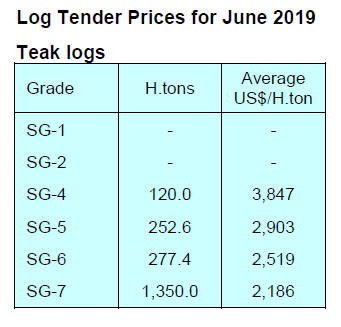
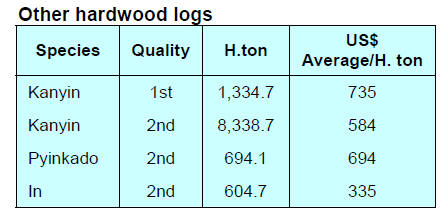
6. INDIA
Modest rise in wood product price
indices
The official Wholesale Price Index for ‘All Commodities’
(Base: 2011-12=100) for June 2019 rose to 121.5 from
121.2 for the previous month.
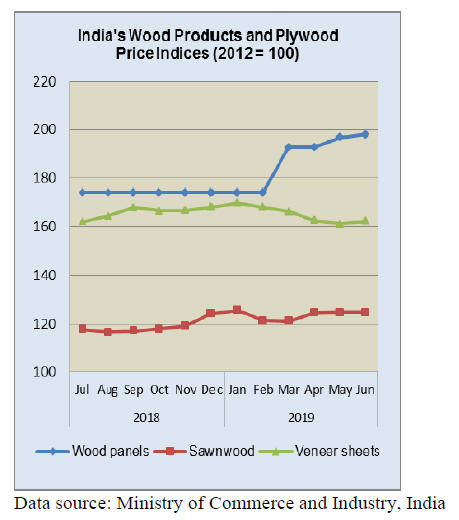
The June index for the group 'Manufactures of Wood
and
of Products of Wood and Cork ' rose to 134.6 from 134.3
(provisional) from the previous month due to higher price
for wooden boxes and crates wood panels however, prices
for veneer sheets declined.
The annual rate of inflation based on monthly WPI in June
stood at 2.02% compared to 5.68% in June in the previous
year.
The press release from the Ministry of Commerce and
Industry can be found at:
http://eaindustry.nic.in/cmonthly.pdf
A first for India – a shipment of pine logs arrives from
Uruguay
For the first time a shipment of pine logs from a country
other than New Zealand has been unloaded in Kandla Port.
Members of the Kandla Timber Association (KTA) were
on hand to view the shipment which it is hoped would
result in more competition in the pine log market.
Navneet Gajjar, president of KTA, said this first shipment
was of 35,000 cubic metres at a price of around US$145
per cubic metre, some US$20 per cubic metre lower than
pine from other sources. Officials from the Plant
Quarantine Station at Kandla said the Uruguayan logs met
Indian phytosanitary standards.
For more see:
https://indianexpress.com/article/cities/ahmedabad/gujarat-firstever-
consignment-of-pinewood-from-uruguay-lands-at-kandlaport-
5805776/
Credit – when they can get, it is too expensive for real
estate developers
Real estate developers have raised alarm over the rapidly
rising costs of borrowing which can be as high as 20%.
Adding to their concerns are the problems in finding loans
even at the high interest rates. This problem stems mainly
because the credit ratings of developers have dropped
significantly.
The impact of this has been seen in the housing starts data.
New housing launches fell by almost 50% in the first
quarter (April-June) of the current financial year and home
sales were down over 10%. Because of the decline in
housing starts India‘s housing inventory declined by over
12% in the past 12 months.
For the full analysis see: https://housing.com/news/proptigercom-
real-insightreport/?
utm_source=internal&utm_medium=email&utm_campai
gn=subscribersDigest
Plantation teak imports
In a slack market along with the ongoing credit squeeze
and high GST there is no mood in the industry to take any
chances on building up stocks which means that C&F
prices for imported plantation teak have stalled.
Serious efforts are being made by importers to ease the
advance payment conditions for GST. The only bright note
is that the rupee exchange rate is stable against the US
dollar.
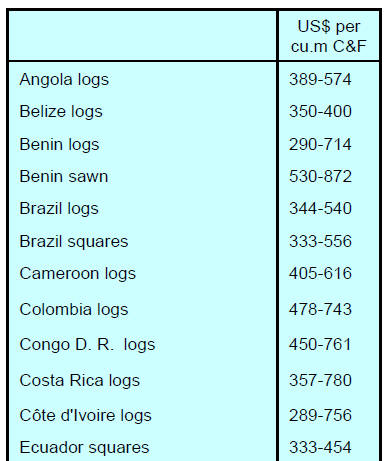
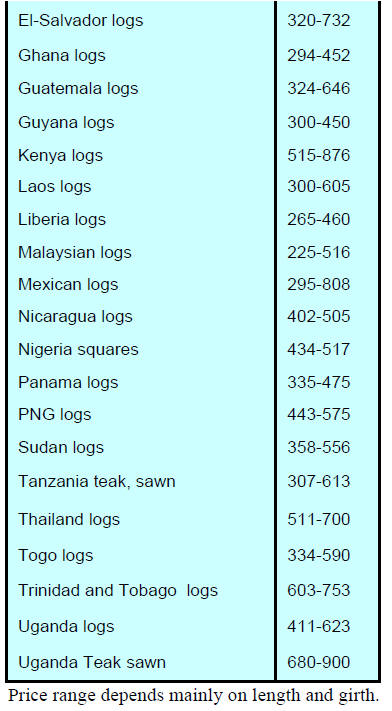
Locally sawn hardwood prices
Active competion in the market for imported hardwoods
has kept prices in check and this is supported by evenly
balanced supply and demand.
Ex-mill prices for imported sawnwood are shown below.
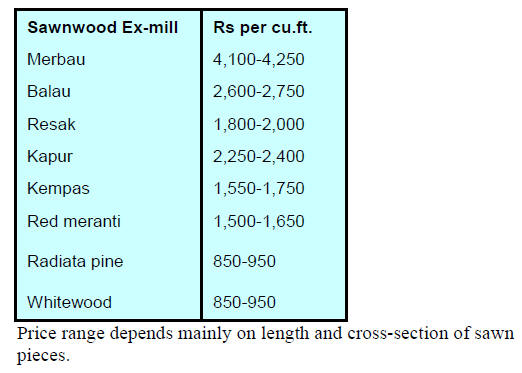
Myanmar teak prices
Anlaysts report that demand for Myanmar teak products
appears to have eased in recent weeks which has resulted
in a drop in the inflow of imports.
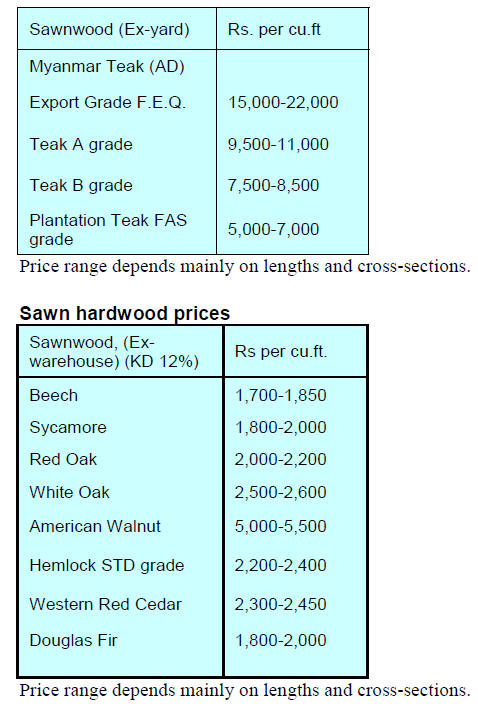
Plywood
The various State Governments have already concluded
the issuing licenses and the entire sector is suffering a log
shortage such that many mills have cut production. The
reduction in GST for the plywood industry is now a matter
of urgency, say analysts, if mill closures are to be avoided.
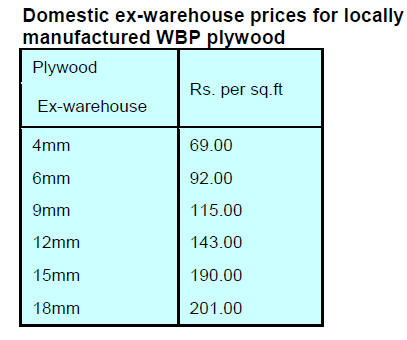
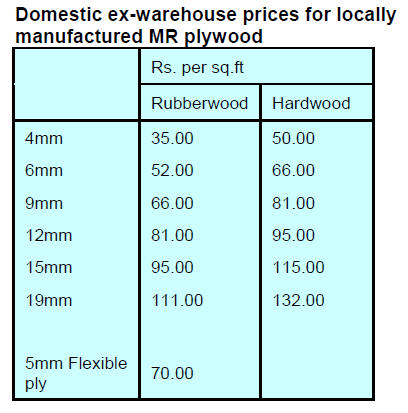
7.
VIETNAM
Vietnam - anti-dumping
investigation on imported MDF
According to the Trade Remedies Authority in the
Ministry of Industry and Trade (MoIT) an anti-dumping
investigation on MDF imported from Thailand and
Malaysia was initiated in October last year.
This investigation was the result of complaints from four
Vietnamese MDF manufacturers on behalf of the domestic
industry. The technical dossier claimed dumping and
damage to local companies.
The Vietnamese firms claimed that the price of imported
MDF from Thailand and Malaysia was below production
cost by between 18-50% which was damaging the
domestic MDF industry.
The Trade Remedies Authority sent questionnaires to local
companies and required a reply by mid-July, 2019 and an
assessment from the Ministry is awaited. This is the first
time Vietnam’s timber industry has raised a trade conflict
to protect the local industry.
First half 2019 trade
The Department of Customs has reported Vietnam’s
exports of wood products in the first 6 months of 2019
were worth US$4.82 billion, up 16.6% over the same
period last year.
Among the top 5 export markets were the US, Japan,
China, South Korea and the EU. Exports to China and
South Korea declined by 30% and 13% respectively.
For the first 6 months of 2019, wood product imports were
valued at US$1.233 billion, up 15% in comparison to the
same period of 2018. Vietnam had a trade value surplus
of US$3.586 billion in wood products in the first 6 months
of 2019.
Opportunities and challenges in the US market
In the first 6 months of 2019 the US continued as
Vietnam’s top export market for wood products with
exports totalling nearly US$2.25 billion, accounting for
47% of total wood product exports.
Analysts in Vietnam’s Ministry of Industry and Trade
anticipate total 2019 wood product exports of US$4 billion
to the US. Furthermore, the US is the biggest suppliers of
timber raw material utilised by Vietnamese manufacturers.
In the first 6 months of 2019 imports of wood products
from the US were worth over US$160 million, a rise of
almost 25% year on year.
It is forecast that the US will become the major supplier of
timber raw material for industries in Vietnam because
large volumes are available the quality is good and the
origin is traceable.
On the downside, there are growing concerns on the risk
of US anti-dumping investigations of Vietnamese exports
and also the risk that not all timber raw material entering
the export supply chain can be verified legal especially
from wood processing industries that have recently
relocated to Vietnam.
Vietnam in action to implement the VPA/FLEGT
The Vietnam-EU VPA/FLEGT came into force 1 June,
2019. According to the Vietnam Administration of
Forestry, the VPA will lead to greater potential for wood
products exports from Vietnam to the EU market. The
adoption of the VPA is also expected to contribute to the
sustainable development of Vietnam’s forests and a strong
commitment to eliminate illegal timber from the supply
chain.
Vietnam will launch its domestic timber legality
assessment system and plans to issue the first FLEGT
license in June, 2020. License legislation for the VPA is
the next step and it is planned to expand this legal
requireto all markets in the future.
See:
https://www.google.com/amp/amp.tapchicongthuong.vn/baiviet/
hiep-dinh-thuong-mai-go-giua-viet-nam-va-eu-da-co-hieuluc-
62957.htm
8. BRAZIL
Paraná embraces SINAFLOR regulations
Paraná State has the highest number of entities registered
under the National Control System for Forest Products
Origin (SINAFLOR). Out of the 2,049 logging permits
granted in Brazil, about 400 have been granted in Paraná
since the system started in May 2018.
According to the Environmental Institute of Paraná
(Instituto Ambiental do Paraná - IAP) the high rate of
adoption of SINAFLOR is the result of training conducted
on the usefulness of the system.
The Water and Land Institute has promoted the use of
SINAFLOR as it brings many benefits, such as stricter
control of the State's forest area, swift document
processing and consequently rapid execution of projects.
The purpose of SINAFLOR is to make forest operation
authorisations transparent, to eliminate fraud in the
issuance of documents and to enable reporting to assist
environmental licensing and enforcement procedures
across the country.
Out of 7,818 projects registered in SINAFLOR throughout
Brazil, 1,549 projects were registered in Paraná.
According to IAP this number testifies to the quality of
training provided by the Institute and the Brazilian
Institute of Environment and Renewable Natural
Resources (IBAMA) on implementation of the system.
Incentives for the timber sector in Santa Catarina
After a long period of stagnation domestic demand for
wood products has started to expand. Enterprises in Santa
Catarina report increased sales and have started to raise
production levels. This is in contrast to the national trend
where sales and production are not improving.
Santa Catarina has entrepreneurs committed to the
development of the sector and the development of the
State. There are around 5,500 small, medium and large
timber, furniture, pulp and forestry companies which
support around 90,000 direct and indirect jobs.
Recently, on the initiative of a State congressman, a
channel for direct dialogue between forest enterprises and
the Santa Catarina state government was established which
will allow the sector to monitor public policies and
infrastructure works to ensure the logistics
competitiveness and economic development of the forestry
sector is maintained.
Agreement between EU and Mercosur will benefit
furniture industry
The Brazilian Association of Furniture Industries
(Abimóvel), an entity that represents the furniture sector in
Brazil, welcomed the agreement between Mercosur and
the European Union as this could help reverse the recent
decline in furniture exports to Europe.
The Commodity Trade Statistics Database (COMTRADE)
shows that Brazilian furniture exports to the EU were
worth just over US$24 million last year.
According to Abimóvel, the biggest challenge will be the
approval of the agreement by the European Parliament and
the Mercosur Legislative branch. Abimóvel is following
efforts of the Brazilian government to ratify the
agreement.
Exports grow in furniture cluster
Exports by the 300 companies in the Bento Gonçalves
furniture cluster in the state of Rio Grande do Sul
increased by over 8% in the first half of 2019 compared to
the same period of the previous year.
According to the Ministry of Economy, Foreign Trade
Secretariat (SECEX), local companies exported US$21
million between January and June 2019.
The pace of export growth from the Bento Gonçalves
region was higher than from the State and the country as a
whole where growth was 1.1% and 1.4%, respectively.
The main markets in the first half of 2019 were Uruguay,
the United States, Puerto Rico, Colombia, Mexico, India,
Bolivia, France, the Dominican Republic and Middle
Eastern countries.
Currently, Uruguay is the main export market for the
Bento Gonçalves furniture cluster followed by the United
States. In the first half 2019 exports to the US grew almost
250% while exports to Uruguay fell slightly.
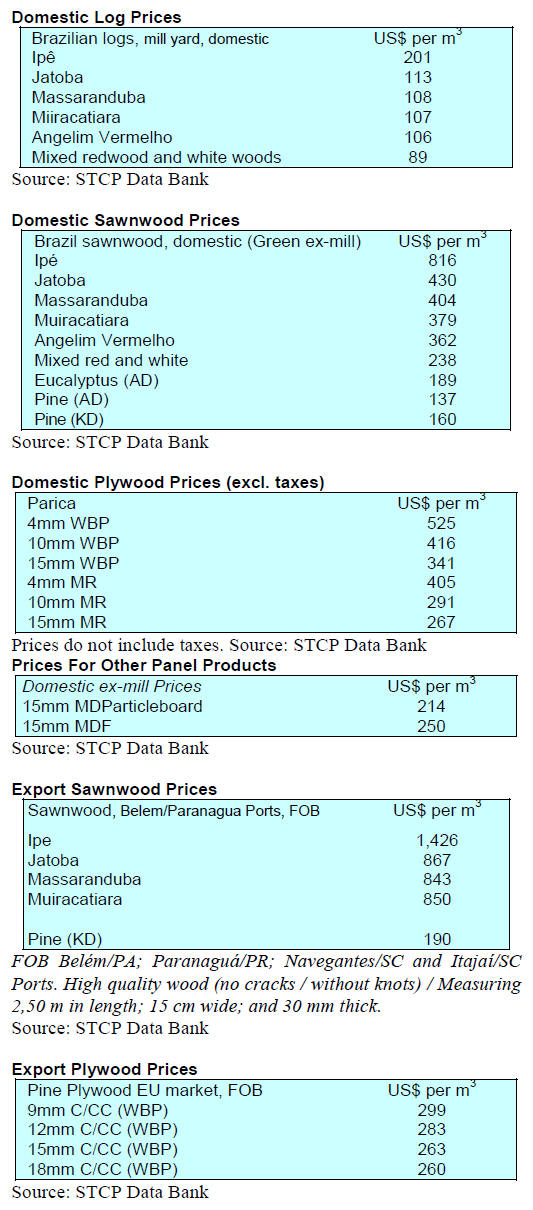

9. PERU
US blocks timber shipment from Peru
A press release from the office of the US Trade
Representative (USTR) has directed the United States
Customs and Border Protection (CBP) to block future
timber imports from a specific Peruvian exporter because
of suspected illegally harvested timber was entering the
company’s supply chain.
This is the second time that the USTR has taken such
action under the United States – Peru Trade Promotion
Agreement’s (PTPA) Annex on Forest Sector Governance.
The USTR order was made after the timber verification
process conducted by the Government of Peru revealed
that a shipment from the company in question was not
harvested in compliance with Peru’s laws and regulations.
See:https://www.pressreleasepoint.com/ustr-announcesenforcement-
action-block-illegal-timber-imports-peru
